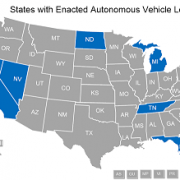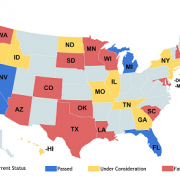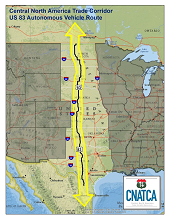States Get to Second Gear on Autonomous Driving Proposals
Burney Simpson
Autonomous and driverless technology proponents should check out a handy guide from the National Conference of State Legislatures (NCSL) on recent legislative proposals at the state level that address the technology.
Sixteen states introduced legislation touching on autonomous vehicles in 2015, according to the NCSL, up from 12 in 2014, and six in 2012.
Only two bills passed in 2015, but nine were carried over, meaning they could be heard in their state’s next legislative session.
Actually, a little more progress occurred. The NCSL notes that Virginia Gov. Terry McAuliffe in June announced the state would be expanding its Virginia Automated Corridors for driverless testing. (See “Va Tech Leaves ‘Em Eating Its Dust in Race to be Top Driverless Test Track,” June 7, 2015). And Utah passed a bill calling for the testing of connected vehicle technology this year.
States can be slow in enacting anything new; legislation often fails once, twice or three times before making it through both the senate and the house chambers, and getting signed by the governor.
The NCSL guide also provides a one-paragraph description of the proposed legislation so you get a sense of the state’s approach without asking a translator to cut through the legalese.
In addition to the legislative list, a US map shows the six states and District of Columbia that have enacted autonomous vehicle legislation. North Dakota and Tennessee this year passed the legislation, joining California, Florida, Michigan, Nevada, and DC, in the cool car club.
The NCSL guide joins the Stanford University Center for Internet and Society pages on Automated Driving and Legislative Action that tracks this topic at the state level.
Why should the autonomous driving industry care what’s going on in individual states?
For one, because that’s where the work is being done. Hundreds of companies and thousands of researchers are working on driverless technology all across the U.S., and the rules and regulations in their state impact their work.
Second, the federal government has problems passing much of anything. The U.S. Congress has been kicking the Department of Transportation budget down the road this year, and 2016 is an election so it will probably get even worse.
Transportation Secretary Anthony Foxx has been a strong voice for autonomous technology. And the US DOT recently awarded $42 million to three connected vehicle projects in Florida, New York, and Wyoming.
But Foxx can only do so much while Congress battles itself. Until that gets solved, check out the action at the state level.
Map graphic by NCSL.



